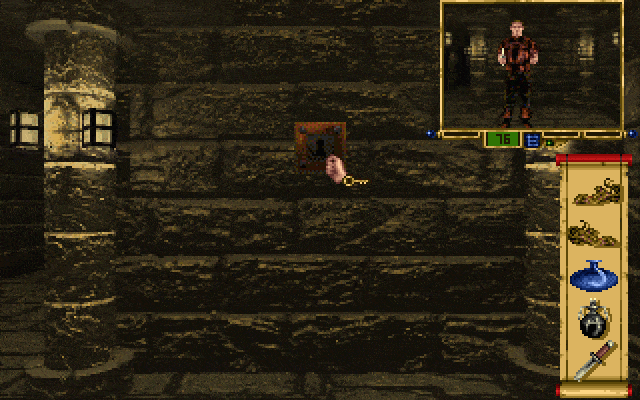Dark Souls 1’s Ash Lake is my favorite location in the game; vast, haunting, mysterious. Visually it hearkens back to the arch trees of the opening cutscene, the enormous trees rising out of the watery depths like mangroves. Then, it dawns on you that you reached this place by climbing down one of these trees. The world is above… what does that mean?
Anyway, it’s a great location and I only found it because I read the Dark Souls wiki. In fact, reading the wiki was instrumental to me enjoying and finishing Dark Souls 1 altogether. I looked up equipment, boss strategies. I was shameless.
Well, probably not shameless. I’m enough of a hardcore gamer to have some sense that you’re supposed to play games without help. You’re supposed to figure things out on your own. But, like I said, even if I felt somehow inadequate because I read guides, those guides were also instrumental to me enjoying the game.
I’ve been playing Stonekeep recently (it’s a realtime first person dungeon crawler from 1995), and I almost stopped at the first difficulty spike. The game was odd, nostalgic, and fun. I was enjoying exploring. Then the Shargas and the slimes on level 2 started steamrolling me and I couldn’t see any way forward (the combat is pretty simple, alternate strategies seemed few or non-existent).
So I looked at the wiki as I contemplated putting the game aside (probably forever). There I learned you could dual wield weapons for an extra attack and I also learned about a secret, very powerful dagger available right at the start of the game, but only accessible by a means so arcane finding it would have been an unlikely accident. I’m still playing the game now, and I expect to finish it.
So what does this mean? Does it mean I’m a filthy casual? Must I turn in my gamer card or git gud? Could be, but I prefer to justify my own behavior in a blog post and suggest that FAQs and wikis and guides, at least for a certain kind of game, are actually valid parts of the gameplay themselves.
Dark Souls and Stonekeep are both examples of this kind of game, and the relevant quality they share is a lack of concern for the fact that they are being played. It is considered modern and somehow mature game design to build a game in such a way that the game teaches the player how to play it. Introduce a new mechanic by explaining it to the player, present him with a clear and simple example, then increase the complexity of the examples, etc. If you’ve played a recent video game you know what I’m talking about.
The issue with this kind of game design is that it erodes, if not destroys, the reality of the game world. If I am being shown and guided and pushed toward the things that will make me feel excited I am the object of the designers actions, not the subject actively exploring. One of the most disappointing realizations in a computer game is thinking you’ve uncovered a secret, or an interesting strategy, or an alternate route, just to be slapped across the face with conclusive evidence that you are just following the critical path; the sudden sense that the designer has succeeded by guiding you with skillful, imperceptible subtly, rather than you succeeding in conquering and understanding the game. But, there is still a design problem. It’s not for nothing that designers guide players.
In the previous couple posts I discussed the divergence between what elements of gameplay represent metaphorically and what they are in the context of the game. This divergence has a serious impact on gameplay itself because what the element of a game represents cannot be used to discover how it will behave. In real life, a sword is 3 feet of sharp steel. There are any number of things you could do, and problems you could solve, with 3 feet of sharp steel, and they don’t necessarily involve stabbing or cutting anyone. In a game though, what looks like a sword is usually just a way of harming enemies. You can’t hack down doors with it, you can’t jimmy open hinged lids with it, nothing.
So something has to be done. The player has to learn, somehow, what the things in the game world are, how they operate and interact, even what the extents and constraints of the game world itself are. And, they might be fooled by what all these things appear to be, as opposed to what they are.
This fooling goes two ways as well. On the one hand, the player might think they can do something because the game object looks like something it isn’t (like the sword which is really just a way of reducing enemy HP). But that is the innocent mistake. The seasoned gamer is likely to have the opposite problem and stop exploring possibilities that aren’t strictly telegraphed to him because the range of implied possibilities, based on appearance, is so much larger than the actual gameplay possibilities. Classic adventure games are the distillation of this problem, where you must put honey on the cat hair to make a mustache to sneak into the night club. You can’t, like, just climb in the open window in the back (because that’s just background scenery).
So, to recap, if a game designer meticulously guides his players through his game, he can end up taking agency away from the player, admitting them to a theme park ride rather than transporting them into a miniature world. On the other hand, if the player doesn’t have any guidance, how does he know how to distinguish game objects from their appearances or know what the bounds of the game world are?
(The feature image was taken from My Abandonware)
